UnitedHealth Group Bundle
How Does UnitedHealth Group Thrive in the Healthcare Market?
UnitedHealth Group (UNH) isn't just another healthcare company; it's a financial powerhouse consistently breaking revenue records. In 2024, its revenue soared to $371.6 billion, highlighting its massive influence in shaping healthcare. This financial strength is crucial for anyone looking to understand the future of healthcare, from investors to industry analysts.
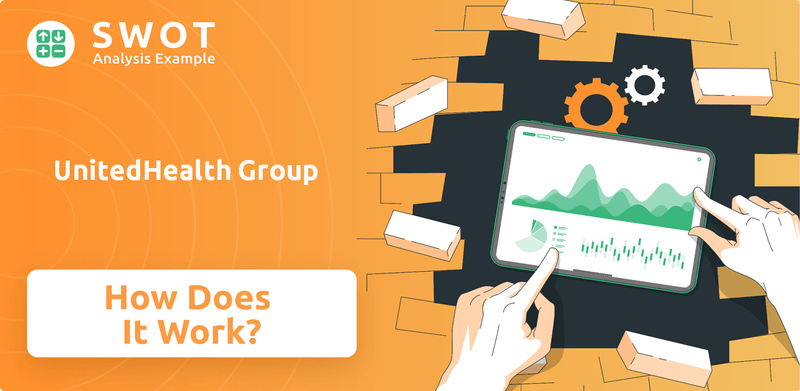
Understanding UnitedHealth's operations is key, especially considering its integrated model encompassing both health insurance through UnitedHealthcare and technology solutions via Optum. Its strategies and financial performance have significant industry-wide implications. For a deeper dive into its strategic positioning, consider exploring the UnitedHealth Group SWOT Analysis to gain a comprehensive understanding of its strengths, weaknesses, opportunities, and threats, providing valuable insights for informed decision-making regarding this leading healthcare company.
What Are the Key Operations Driving UnitedHealth Group’s Success?
UnitedHealth Group (UNH) operates through two main segments, each contributing to its integrated healthcare model. These segments are UnitedHealthcare and Optum, which work together to provide a wide array of health services. This structure enables the company to offer comprehensive solutions, from health insurance plans to advanced healthcare services, aiming to improve healthcare access and outcomes.
The company's value proposition centers on improving healthcare affordability and access for its members. UnitedHealth Group leverages its scale and integrated operations to manage costs and enhance the quality of care. This approach is supported by significant investments in technology and data analytics, which drive efficiency and innovation across its business lines. The company's strategy is designed to create value for its stakeholders, including members, providers, and shareholders.
Understanding how UnitedHealth Group works involves examining the core operations and value propositions of its two primary segments: UnitedHealthcare and Optum. These segments are key to the company's ability to serve a vast customer base and maintain its position as a leading healthcare company. The company's ability to adapt to market changes and technological advancements is critical to its sustained success.
UnitedHealthcare focuses on providing health benefits to individuals, employers, and government entities. Its operations include extensive network management, claims processing, customer service, and regulatory compliance. The segment offers a variety of health insurance plans, including commercial, Medicare, and Medicaid products. This segment serves a vast customer base, aiming to improve healthcare access and affordability for its members.
The value proposition of UnitedHealthcare lies in offering comprehensive health coverage and managing healthcare costs for its members. It aims to provide accessible and affordable healthcare solutions through a broad network of providers and innovative health plans. The segment focuses on improving health outcomes and providing a positive experience for its members. This approach is supported by strategic investments in technology and data analytics.
Optum is a diversified health services company that provides technology-enabled health services. It includes pharmacy care services, data analytics, healthcare delivery, and advisory services. Optum's operational processes encompass advanced data analytics, technology development for electronic health records, and direct patient care through its OptumCare division. The supply chain involves strategic partnerships with pharmaceutical companies, technology vendors, and healthcare systems.
Optum's value lies in its integrated approach to healthcare, leveraging data and technology to optimize care delivery and improve health outcomes. This segment focuses on improving efficiency, reducing costs, and enhancing the quality of care. Optum's core capabilities differentiate UnitedHealth Group from traditional health insurers by providing a comprehensive suite of services.
UnitedHealth Group differentiates itself through its integrated business model, combining health insurance with health services. This integration allows for better management of healthcare costs and improved patient outcomes. The company's financial performance reflects its strong market position and strategic execution.
- In 2023, UnitedHealth Group reported revenues of approximately $371.6 billion, demonstrating significant growth.
- The company's adjusted earnings per share (EPS) for 2023 were around $24.18, reflecting strong profitability.
- Optum's revenue contribution continues to grow, with OptumHealth serving over 106 million people as of 2023.
- UnitedHealth Group continues to invest heavily in technology and data analytics to enhance its services and maintain a competitive edge. For more insights, check out the Growth Strategy of UnitedHealth Group.
UnitedHealth Group SWOT Analysis
- Complete SWOT Breakdown
- Fully Customizable
- Editable in Excel & Word
- Professional Formatting
- Investor-Ready Format
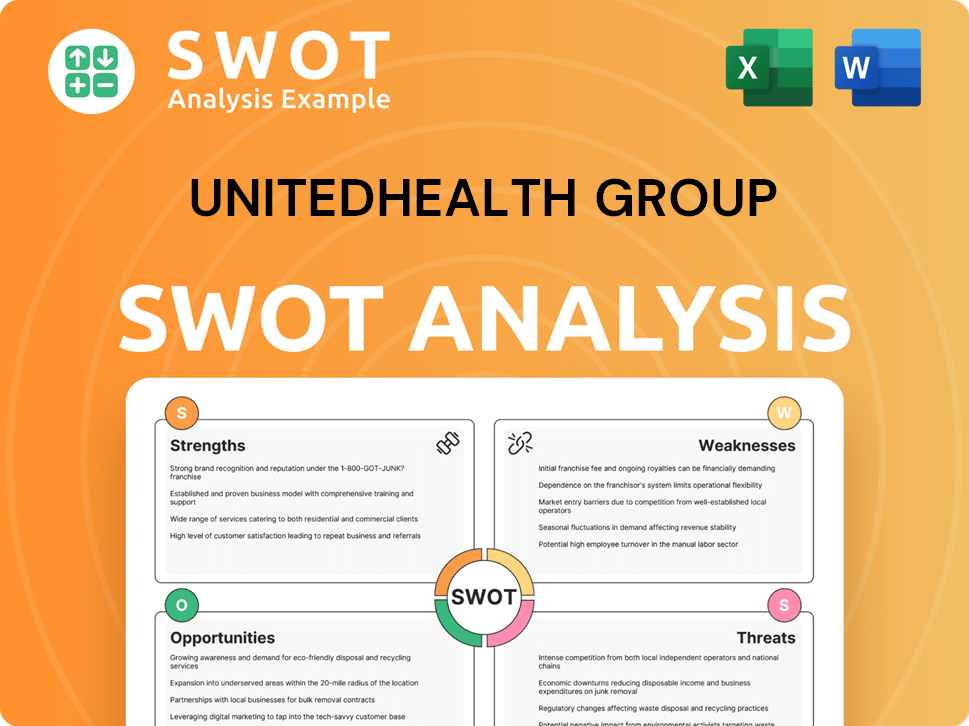
How Does UnitedHealth Group Make Money?
Understanding the revenue streams and monetization strategies of UnitedHealth Group (UNH) is crucial for investors and stakeholders. The company's financial success hinges on its ability to generate revenue through its diverse business segments, primarily UnitedHealthcare and Optum. These segments employ distinct strategies to capture value within the healthcare market.
For the full year 2024, UnitedHealthcare and Optum generated substantial revenues, reflecting their significant contributions to the overall financial performance of UnitedHealth Group. The following sections will delve into the specifics of how each segment operates and generates revenue.
This analysis provides insights into the operational and financial dynamics of a leading healthcare company, offering a comprehensive view of its strategic approach to revenue generation and market positioning. Further insights can be found in the Growth Strategy of UnitedHealth Group.
The UnitedHealthcare segment is a key driver of UnitedHealth Group's revenue, primarily through health insurance plans. The monetization strategy focuses on managing risk and providing access to a broad network of healthcare providers. Pricing structures are based on actuarial data and healthcare utilization trends.
- Revenue Source: Premiums from health insurance plans.
- Customer Base: Commercial, Medicare, and Medicaid members.
- Monetization Strategy: Risk management, provider network access, and actuarial-based pricing.
- 2024 Revenue: $289.7 billion, representing the largest portion of the company's total revenue.
The Optum segment contributes significantly to UnitedHealth Group's revenue, with a diverse portfolio of services. Optum focuses on pharmacy care, healthcare delivery, and technology solutions. Monetization strategies include platform fees, bundled services, and performance-based contracts.
- Revenue Sources: Pharmacy care (OptumRx), healthcare delivery (OptumCare), and technology & consulting (OptumInsight).
- Monetization Strategies: Platform fees, bundled services, and performance-based contracts.
- OptumRx: Prescription drug sales and pharmacy benefit management fees.
- OptumCare: Direct patient care services, often through value-based care.
- OptumInsight: Data analytics, consulting, and technology solutions.
- 2024 Revenue: $225.7 billion, demonstrating significant growth.
UnitedHealth Group PESTLE Analysis
- Covers All 6 PESTLE Categories
- No Research Needed – Save Hours of Work
- Built by Experts, Trusted by Consultants
- Instant Download, Ready to Use
- 100% Editable, Fully Customizable
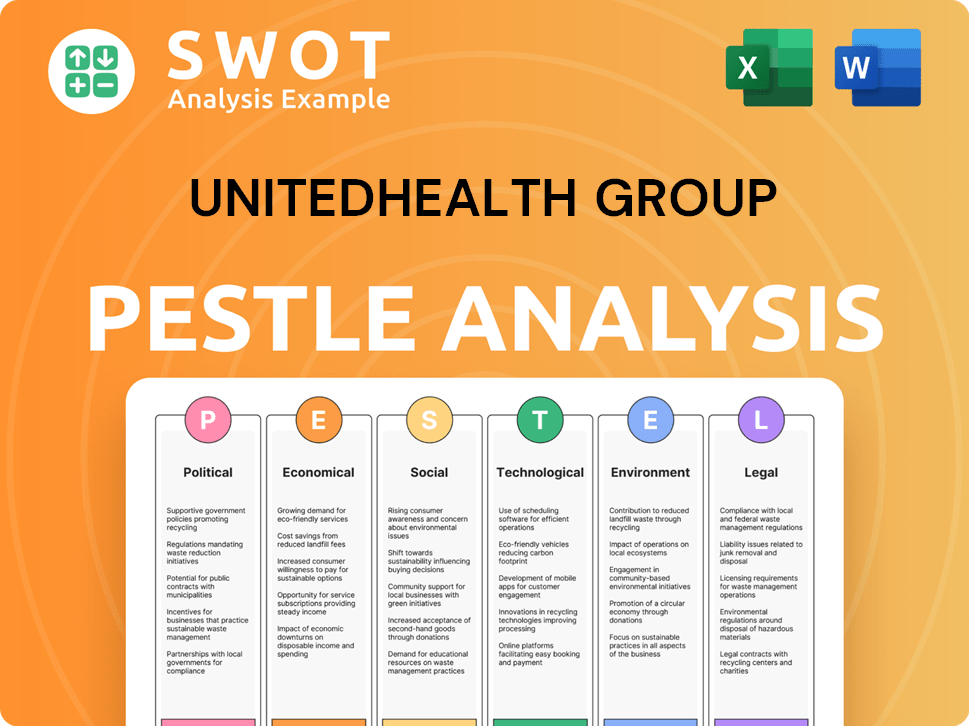
Which Strategic Decisions Have Shaped UnitedHealth Group’s Business Model?
The evolution of UnitedHealth Group (UNH) has been shaped by significant milestones and strategic decisions, solidifying its position as a leading healthcare company. A key strategy has been the continuous expansion and integration of Optum, its technology-driven health services business. This has allowed UnitedHealth to diversify beyond traditional health insurance, creating a more integrated healthcare ecosystem.
The company has navigated operational and market challenges, including regulatory changes and the complexities of managing a vast network of providers and members. UnitedHealth Group has responded by leveraging its data analytics capabilities within Optum to adapt to new regulations, optimize care models, and manage population health more effectively. Its competitive advantages are multifaceted: a strong brand reputation, significant economies of scale, and technological leadership through Optum's advanced data analytics and IT solutions.
The integrated model, where Optum's services support UnitedHealthcare's health plans, creates a unique competitive edge by allowing for better cost control, improved health outcomes, and a more seamless member experience. The company continues to adapt to new trends like value-based care and digital health innovation, investing in telehealth and AI-driven solutions to maintain its leadership position in the health insurance and managed care markets.
Key milestones include the strategic acquisitions of healthcare technology and service companies under the Optum umbrella. This has allowed for diversification beyond traditional health insurance. The ongoing expansion of OptumCare has deepened its direct care delivery capabilities, a strategic move to control costs and improve care coordination.
Strategic moves involve the continuous expansion and integration of the Optum segment, enhancing its technological capabilities. Leveraging data analytics for adapting to regulatory changes and optimizing care models is also a key strategy. Investment in telehealth and AI-driven solutions to maintain its leadership position in the industry.
UnitedHealth Group's competitive advantages stem from its strong brand reputation and significant economies of scale. Technological leadership through Optum's advanced data analytics and IT solutions provides a distinct advantage. The integrated model allows for better cost control, improved health outcomes, and a more seamless member experience.
In 2024, UnitedHealth Group reported revenues of approximately $421.0 billion. The company's adjusted earnings per share for 2024 were around $25.13. The company's market capitalization is substantial, reflecting its leading position in the healthcare industry. Furthermore, the company's investments in Optum have significantly contributed to its revenue growth and market share.
The company faces challenges such as evolving regulatory landscapes, including changes to the Affordable Care Act. Managing a vast network of providers and members presents operational complexities. Adapting to new trends like value-based care and digital health innovation requires continuous investment and strategic adjustments.
- Regulatory Changes: Adapting to evolving healthcare regulations.
- Provider Network: Managing a large and complex network of providers.
- Technological Advancements: Investing in telehealth and AI-driven solutions.
- Market Competition: Maintaining a competitive edge in a dynamic market.
UnitedHealth Group Business Model Canvas
- Complete 9-Block Business Model Canvas
- Effortlessly Communicate Your Business Strategy
- Investor-Ready BMC Format
- 100% Editable and Customizable
- Clear and Structured Layout
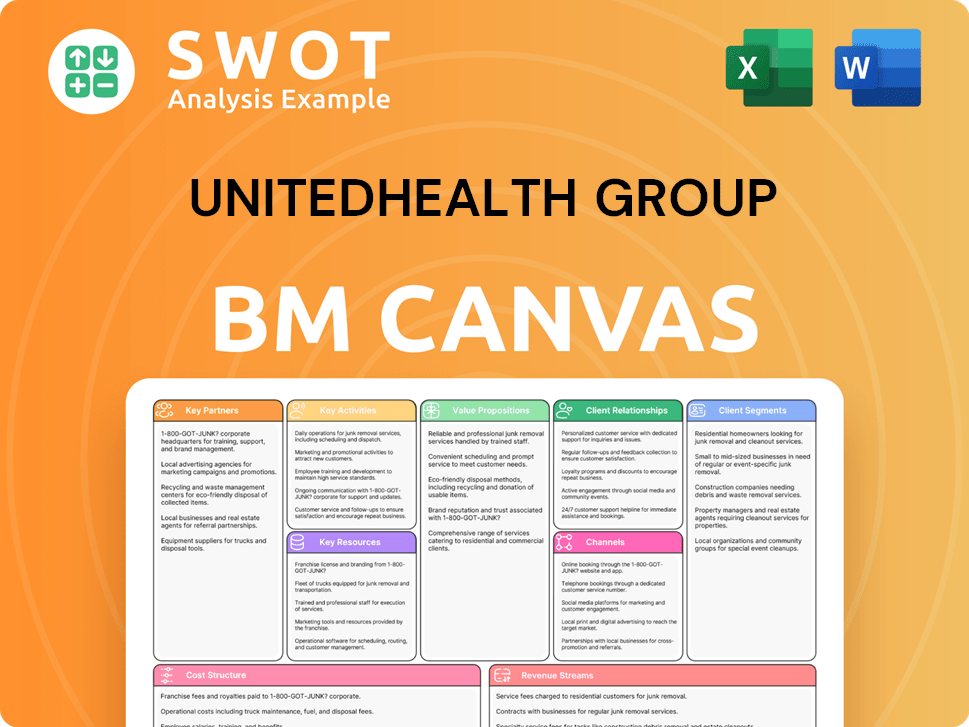
How Is UnitedHealth Group Positioning Itself for Continued Success?
As a leading diversified healthcare company, UnitedHealth Group (UNH) holds a significant position in the healthcare industry. It is consistently ranked among the largest healthcare companies globally, with a substantial market share in health insurance, particularly in Medicare Advantage. Its integrated approach and comprehensive offerings contribute to strong customer loyalty, solidifying its industry standing.
UnitedHealth Group's industry position is bolstered by its extensive reach, which includes both domestic and international operations. The company's Optum segment further expands its influence in healthcare services and technology. This diversified structure allows UnitedHealth Group to serve a broad range of customers and stakeholders, enhancing its market presence and financial performance. For example, in 2024, the company's revenue reached approximately $372 billion, demonstrating its financial strength and market leadership.
UnitedHealth Group faces several risks that could impact its operations. Regulatory changes in the U.S. healthcare market, such as shifts in insurance mandates or reimbursement models, pose a significant threat. The emergence of new competitors and technological disruptions also present challenges. Additionally, cybersecurity threats and data privacy concerns are ongoing risks.
The future outlook for UnitedHealth Group involves strategic initiatives, including continued investment in the Optum segment and expansion of value-based care models. The company is focused on leveraging advanced analytics and AI to improve healthcare outcomes. The company plans to sustain and expand its ability to make money by continuing to integrate its health benefits and services, optimizing its care delivery models, and exploring new markets and partnerships.
Regulatory changes, particularly within the U.S. healthcare system, pose a significant risk. Changes in insurance mandates, reimbursement models, and antitrust enforcement could directly affect UnitedHealth Group's operations and financial results. The competitive landscape is also evolving, with tech-enabled healthcare startups and established players vying for market share. These competitors could disrupt traditional healthcare models.
Technological advancements and operational risks are also considerable. Cybersecurity threats and data privacy concerns are ongoing challenges, given the vast amount of sensitive health information the company manages. The adoption of new technologies and the integration of data analytics also present operational hurdles. The company must continuously invest in security and technology infrastructure to mitigate these risks effectively.
Looking ahead, UnitedHealth Group is focused on several key strategic initiatives. These include continued investments in its Optum segment, expansion of value-based care models, and leveraging advanced analytics and artificial intelligence to enhance healthcare outcomes and efficiency. The company's commitment to innovation, personalized care, and addressing healthcare affordability will be critical for future success. To learn more about the company's historical context, you can read a Brief History of UnitedHealth Group.
- Optum Expansion: Continued growth and investment in Optum's services and technology platforms.
- Value-Based Care: Expanding value-based care models to improve patient outcomes and manage costs.
- Technology Integration: Leveraging advanced analytics and AI for improved efficiency and personalized care.
- Market Expansion: Exploring new markets and partnerships to diversify revenue streams.
UnitedHealth Group Porter's Five Forces Analysis
- Covers All 5 Competitive Forces in Detail
- Structured for Consultants, Students, and Founders
- 100% Editable in Microsoft Word & Excel
- Instant Digital Download – Use Immediately
- Compatible with Mac & PC – Fully Unlocked
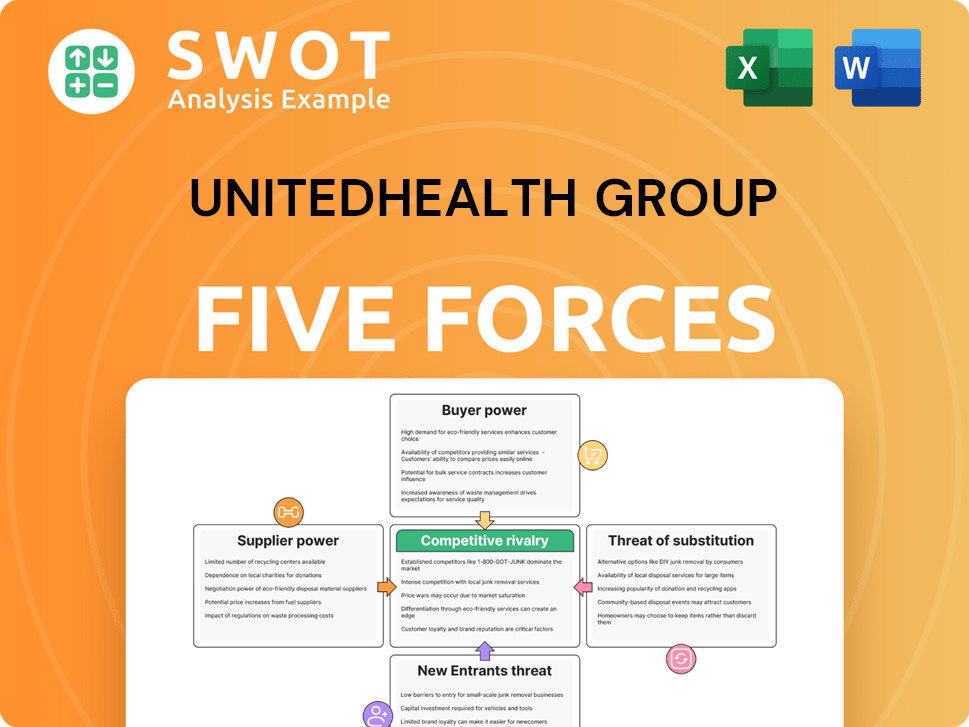
Related Blogs
- What are Mission Vision & Core Values of UnitedHealth Group Company?
- What is Competitive Landscape of UnitedHealth Group Company?
- What is Growth Strategy and Future Prospects of UnitedHealth Group Company?
- What is Sales and Marketing Strategy of UnitedHealth Group Company?
- What is Brief History of UnitedHealth Group Company?
- Who Owns UnitedHealth Group Company?
- What is Customer Demographics and Target Market of UnitedHealth Group Company?
Disclaimer
All information, articles, and product details provided on this website are for general informational and educational purposes only. We do not claim any ownership over, nor do we intend to infringe upon, any trademarks, copyrights, logos, brand names, or other intellectual property mentioned or depicted on this site. Such intellectual property remains the property of its respective owners, and any references here are made solely for identification or informational purposes, without implying any affiliation, endorsement, or partnership.
We make no representations or warranties, express or implied, regarding the accuracy, completeness, or suitability of any content or products presented. Nothing on this website should be construed as legal, tax, investment, financial, medical, or other professional advice. In addition, no part of this site—including articles or product references—constitutes a solicitation, recommendation, endorsement, advertisement, or offer to buy or sell any securities, franchises, or other financial instruments, particularly in jurisdictions where such activity would be unlawful.
All content is of a general nature and may not address the specific circumstances of any individual or entity. It is not a substitute for professional advice or services. Any actions you take based on the information provided here are strictly at your own risk. You accept full responsibility for any decisions or outcomes arising from your use of this website and agree to release us from any liability in connection with your use of, or reliance upon, the content or products found herein.